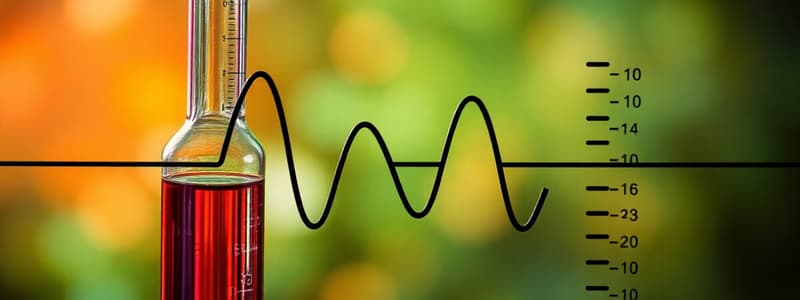Podcast
Questions and Answers
What effect does non-competitive inhibition have on Vmax?
What effect does non-competitive inhibition have on Vmax?
- Vmax is increased
- Vmax is decreased (correct)
- Vmax is doubled
- Vmax remains unchanged
How does uncompetitive inhibition affect KM?
How does uncompetitive inhibition affect KM?
- KM remains unchanged
- KM is decreased (correct)
- KM is increased
- KM varies based on the concentration of the substrate
Which statement about non-competitive inhibition is true?
Which statement about non-competitive inhibition is true?
- The substrate can bind to the enzyme-inhibitor complex, but it does not progress to product (correct)
- The KM changes due to a higher substrate affinity
- The inhibitor binds only to the free enzyme
- The Vmax increases due to increased substrate concentration
What is the main characteristic of uncompetitive inhibition?
What is the main characteristic of uncompetitive inhibition?
In competitive inhibition, how does the KM change?
In competitive inhibition, how does the KM change?
What effect do competitive inhibitors have on the maximum velocity (Vmax) of an enzyme?
What effect do competitive inhibitors have on the maximum velocity (Vmax) of an enzyme?
Which type of inhibitor would most likely require calculating the KI value?
Which type of inhibitor would most likely require calculating the KI value?
How do irreversible inhibitors primarily affect enzymes?
How do irreversible inhibitors primarily affect enzymes?
Which of the following best describes mechanism-based irreversible inhibitors?
Which of the following best describes mechanism-based irreversible inhibitors?
Which of the following does NOT result from reversible enzyme inhibition?
Which of the following does NOT result from reversible enzyme inhibition?
What is the characteristic change in Km for uncompetitive inhibitors?
What is the characteristic change in Km for uncompetitive inhibitors?
In enzyme regulation, what is the primary goal of modulating enzyme activity?
In enzyme regulation, what is the primary goal of modulating enzyme activity?
Diisopropylfluorophosphate (DIFP) is known as what type of inhibitor?
Diisopropylfluorophosphate (DIFP) is known as what type of inhibitor?
How do enzymes respond when a product is available in excess?
How do enzymes respond when a product is available in excess?
What is the function of allosteric modulators in enzyme regulation?
What is the function of allosteric modulators in enzyme regulation?
Which of the following describes reversible covalent modification?
Which of the following describes reversible covalent modification?
What is the role of proteolytic cleavage in enzyme regulation?
What is the role of proteolytic cleavage in enzyme regulation?
Which statement best describes feedback regulation?
Which statement best describes feedback regulation?
What initiates the activation of a zymogen?
What initiates the activation of a zymogen?
What is an example of an enzyme regulated by proteolytic cleavage mentioned?
What is an example of an enzyme regulated by proteolytic cleavage mentioned?
What distinguishes reversible enzyme inhibitors from irreversible ones?
What distinguishes reversible enzyme inhibitors from irreversible ones?
What does KM represent in Michaelis-Menten kinetics?
What does KM represent in Michaelis-Menten kinetics?
What does a Lineweaver-Burk plot visually represent?
What does a Lineweaver-Burk plot visually represent?
How can Vmax be experimentally estimated?
How can Vmax be experimentally estimated?
Which statement is true about enzyme inhibitors?
Which statement is true about enzyme inhibitors?
What happens to the initial reaction rate when [S] is much greater than KM?
What happens to the initial reaction rate when [S] is much greater than KM?
Which of the following enzymes are considered irreversible inhibitors?
Which of the following enzymes are considered irreversible inhibitors?
What role do enzyme inhibitors play in medicine?
What role do enzyme inhibitors play in medicine?
Which part of the Lineweaver-Burk plot corresponds to Vmax?
Which part of the Lineweaver-Burk plot corresponds to Vmax?
What characterizes competitive inhibition in enzyme activity?
What characterizes competitive inhibition in enzyme activity?
What is represented by the inhibitor constant KI?
What is represented by the inhibitor constant KI?
What happens to the Michaelis-Menten constant (KM) in the presence of a competitive inhibitor?
What happens to the Michaelis-Menten constant (KM) in the presence of a competitive inhibitor?
How does non-competitive inhibition differ from competitive inhibition?
How does non-competitive inhibition differ from competitive inhibition?
Which statement correctly describes the effect of a competitive inhibitor when substrate concentration is much higher than inhibitor concentration?
Which statement correctly describes the effect of a competitive inhibitor when substrate concentration is much higher than inhibitor concentration?
What is the role of ethanol in the context of methanol poisoning?
What is the role of ethanol in the context of methanol poisoning?
What is the consequence of non-competitive inhibition on the Vmax of an enzyme-catalyzed reaction?
What is the consequence of non-competitive inhibition on the Vmax of an enzyme-catalyzed reaction?
Which of the following is true regarding the binding of an inhibitor in competitive inhibition?
Which of the following is true regarding the binding of an inhibitor in competitive inhibition?
Flashcards
Michaelis-Menten Kinetics
Michaelis-Menten Kinetics
A model describing how enzyme activity changes with substrate concentration, explaining why reaction rate is ultimately limited by enzyme amount.
Vmax
Vmax
The maximum initial reaction rate achievable by an enzyme when the active site is saturated with substrate.
KM
KM
The substrate concentration at which the reaction rate is half the maximum rate (Vmax).
Lineweaver-Burk plot
Lineweaver-Burk plot
Signup and view all the flashcards
Enzyme Inhibitor
Enzyme Inhibitor
Signup and view all the flashcards
Reversible Enzyme Inhibitors
Reversible Enzyme Inhibitors
Signup and view all the flashcards
Irreversible Enzyme Inhibitors
Irreversible Enzyme Inhibitors
Signup and view all the flashcards
Competitive Inhibitor
Competitive Inhibitor
Signup and view all the flashcards
Inhibitor Constant (KI)
Inhibitor Constant (KI)
Signup and view all the flashcards
Competitive Inhibition Effect on Vmax
Competitive Inhibition Effect on Vmax
Signup and view all the flashcards
Competitive Inhibition Effect on KM
Competitive Inhibition Effect on KM
Signup and view all the flashcards
Non-competitive Inhibitor
Non-competitive Inhibitor
Signup and view all the flashcards
Ethanol as Antidote
Ethanol as Antidote
Signup and view all the flashcards
Non-competitive Inhibition
Non-competitive Inhibition
Signup and view all the flashcards
Competitive Inhibition
Competitive Inhibition
Signup and view all the flashcards
Uncompetitive Inhibition
Uncompetitive Inhibition
Signup and view all the flashcards
Michaelis-Menten Equation
Michaelis-Menten Equation
Signup and view all the flashcards
Vmax
Vmax
Signup and view all the flashcards
KM
KM
Signup and view all the flashcards
Competitive Inhibition
Competitive Inhibition
Signup and view all the flashcards
Non-competitive Inhibition
Non-competitive Inhibition
Signup and view all the flashcards
Uncompetitive Inhibition
Uncompetitive Inhibition
Signup and view all the flashcards
Lineweaver-Burke Plot
Lineweaver-Burke Plot
Signup and view all the flashcards
Irreversible Inhibition
Irreversible Inhibition
Signup and view all the flashcards
Mechanism-based Inhibitors
Mechanism-based Inhibitors
Signup and view all the flashcards
Enzyme Regulation
Enzyme Regulation
Signup and view all the flashcards
Enzyme Regulation
Enzyme Regulation
Signup and view all the flashcards
Allosteric Regulation
Allosteric Regulation
Signup and view all the flashcards
Reversible Covalent Modification
Reversible Covalent Modification
Signup and view all the flashcards
Proteolytic Cleavage
Proteolytic Cleavage
Signup and view all the flashcards
Feedback Regulation
Feedback Regulation
Signup and view all the flashcards
Allosteric activation
Allosteric activation
Signup and view all the flashcards
Allosteric deactivation
Allosteric deactivation
Signup and view all the flashcards
Zymogen
Zymogen
Signup and view all the flashcards
Pro-enzyme
Pro-enzyme
Signup and view all the flashcards
Study Notes
Biochemistry Lecture Notes - Enzymes
- Topic 3: Enzymes
- Lecture 7: Basic concepts – catalysis, transition states, and binding energy.
- Lecture 8: Enzyme classes and enzyme kinetics.
- Lecture 9: Enzyme inhibition and regulation.
Michaelis-Menten Kinetics
- The Michaelis-Menten equation describes enzyme kinetics.
- It relates reaction velocity (V0) to substrate concentration ([S]).
- V0 = (Vmax[S])/(KM + [S])
- Vmax: maximum reaction velocity
- KM: Michaelis constant, substrate concentration at half-maximal velocity.
- When [S] << KM, the initial rate is proportional to [S].
- When [S] >> KM, the initial rate is independent of [S].
- When [S] = KM, the reaction rate is half the maximal rate.
Measuring KM and Vmax
-
Vmax is an upper limit, never truly achieved.
-
Experimental determination:
- Measuring the initial rate of catalysis (V0) at varying substrate concentrations ([S]).
- Using curve-fitting programs to determine KM and Vmax.
-
Lineweaver-Burk plot:
- A plot of 1/V0 vs 1/[S].
- Yields a straight line with a y-intercept of 1/Vmax and a slope of KM/Vmax.
- The x-intercept is -1/KM.
Enzyme Inhibition
- Molecules that interfere with enzyme catalysis, slowing or halting enzymatic transformations.
- Important for pharmaceuticals.
SpecificReversible- Competitive
- Non-competitive.
- Uncompetitive.
Non-Specific- Irreversible
- Inhibitors vary in how they affect enzyme activity.
Competitive Inhibition
- Inhibitor competes with the substrate for the enzyme's active site.
- Inhibitor constant (KI) indicates inhibitor potency.
- KM increases (apparent KM) in the presence of an inhibitor.
V<sub>max</sub>remains unchanged.
Non-competitive Inhibition
- The inhibitor binds to a site distinct from the active site, on either the free enzyme or the enzyme-substrate complex.
- Binding of the inhibitor does not inactivate the enzyme.
K<sub>M</sub>remains unchanged.V<sub>max</sub>decreases.
Uncompetitive Inhibition
- Inhibitor binds to the enzyme-substrate complex but not to the free enzyme, at a site distinct from the substrate site.
- Binding of the inhibitor does not inactivate the enzyme.
- Both KM and Vmax decrease.
Irreversible Inhibition
- Inhibitors covalently modify an essential functional group on the enzyme.
- Enzyme activity is permanently lost.
- Example: Diisopropylfluorophosphate (DIFP), a highly toxic sarin gas analogue that inhibits serine proteases.
Enzyme Regulation
-
Mechanisms cells use to control enzyme activity include allosteric regulation, reversible covalent modification (e.g., phosphorylation), proteolytic cleavage, and feedback regulation.
-
Allosteric Regulation*—Regulatory molecules alter enzyme activity by binding to sites other than the active site, changing enzyme shape.
-
Activation – active site becomes available.
-
Deactivation – active site becomes unavailable.
-
Reversible Covalent Modification: Enzyme activity is modulated by covalent modification of amino acid residues.
-
Proteolytic Cleavage: Enzymes are produced in an inactive form (zymogen/proenzyme), activated after cleavage.
-
Feedback Regulation: The end product of a metabolic pathway inhibits an upstream enzyme, limiting further product production.
Studying That Suits You
Use AI to generate personalized quizzes and flashcards to suit your learning preferences.




